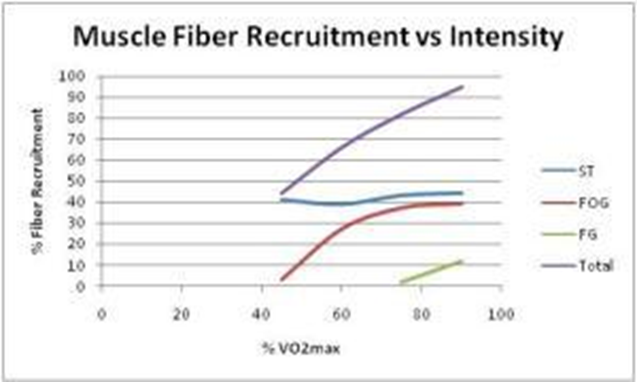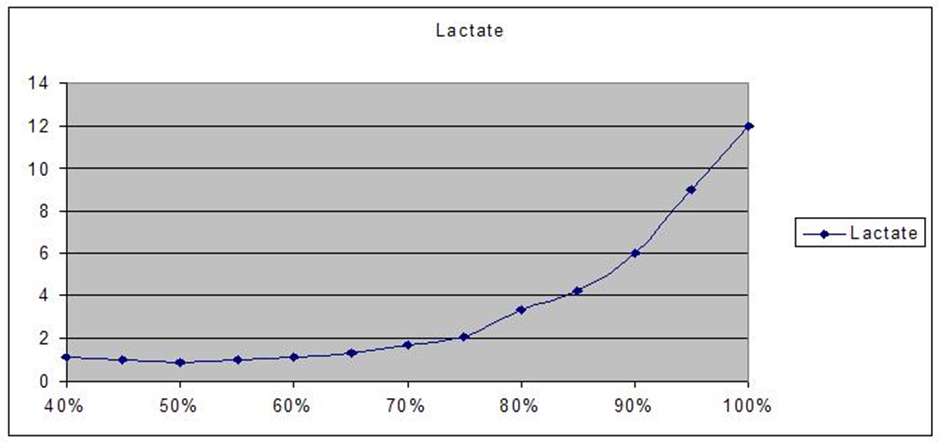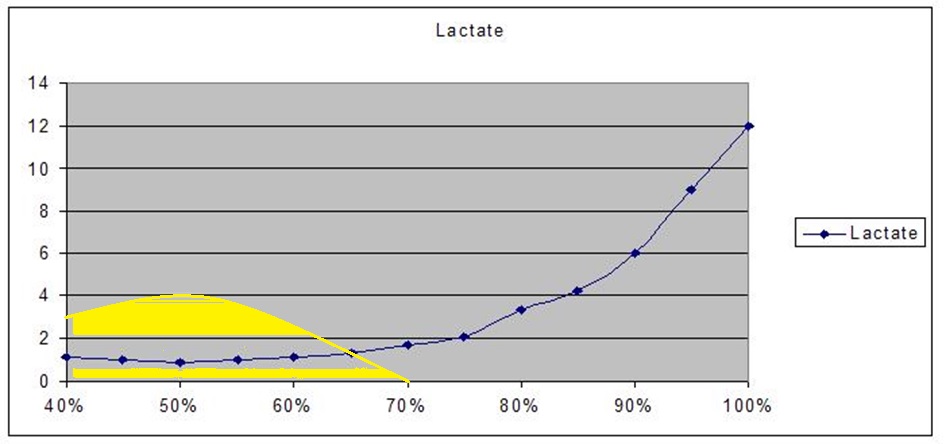Endurance Physiology 101: The Basics.
Alan Couzens, M.Sc. (Sports Science)
Updated: Nov 2nd, 2016

This is an updated version of a 2006 article that I wrote for the old Endurance Corner website.
In preparation for the launch of the official Endurance Corner website (stay tuned), Gordo has asked me to compile a couple of concise, core articles that will give our readers a background in the exercise physiology behind some of the triathlon terminology that we use and the training philosophy that we espouse. This is the first of those core articles.
If you've been involved in endurance sports for any period of time, you've probably come to realize that there are a myriad of terms across training systems - functional threshold, aerobic threshold, lactate threshold, etc. - some with direct physiological definitions, some with conflicting definitions (!) and some a little more 'fuzzy'.
Even for those of us with some background in physiology, it can get confusing 'speaking multiple languages'. So, this first article will seek to review some of the basic, pertinent exercise physiology for endurance athletes & explain how some of the above terms relate on a physiological level.
Let’s begin our ex phys 101 class with a brief review of one of the most important foundational concepts, that of muscle fiber type.
Fiber Types
Just as the chicken has both dark meat and white meat, we humans also have muscles (meat) that is white, or dark in concert with its purpose. The ‘dark meat’ is made up, primarily, of slowtwitch fibers. Whereas the ‘white meat’ is made up of, more explosive, fast twitch fibers.
A good portion of our leg meat (for example the Soleus muscle of the lower leg) is predominantly ‘dark meat’, full of oxygen processing mitochondria (and the associated red pigmented cytochrome complexes) and myoglobin. Whereas, muscles responsible for more explosive movements, for example the ‘pushing’ muscles of the upper arm (triceps brachii) contain more fast twitch (white) fibers. In a very real sense, function dictates form.
Just as there are differences between different muscle groups within one human body associated with the muscle function. There are also vast differences between humans in the proportion of slow twitch and fast twitch fibers within the ‘prime mover’ muscles. Elite endurance athletes may exhibit 80% or more slow twitch fibers, while power lifters will show a majority of fast twitch fibers. Most of us will exhibit a fairly even 50-50 split.
While there is still some scientific debate, the most popular position is that the proportion of slow twitch and fast twitch fibers within the body is largely genetically determined. That is, shortly after birth the number of slow and fast twitch fibers within your body is fixed. This can be a depressing revelation for the aspiring endurance athlete, but fear not. There is hope on the horizon, a subtype of the Fast Twitch Fiber group, the Fast Oxidative Glycolytic (FOG) fiber can change dramatically to take on characteristics very similar to the slow twitch fiber, i.e. you can start with a bucket full of KFC’s white meat and with a few hundred thousand waves of your magic wand, it can be miraculously transformed into something that better resembles a juicy bucket of dark meat.
The Aerobic Threshold
Not surprisingly, this transition between using your “dark meat” and your “white meat” is a critical training intensity.
Also unsurprisingly, there is limited upside in making your dark meat more dark. There is a lot more benefit to spending your precious training time devoted to turning your white meat (fast glycolytic fibers) into dark meat (fast oxidative glycolytic fibers). This transition typically occurs somewhere between 40-60% of your VO2max as displayed in the chart below. In the real world of training, this represents a pretty wide range. For a 40 year old male, this could mean heart rates of anywhere from 90bpm to 130bpm. Now, remember, this is a critical point. While there is certainly no harm training below this point, there is limited potential to making your dark meat more dark.

Well, if I don't want to waste time making my dark meat darker, you say, I’m going to shoot for the high end of the range. The problem with this approach is that there is another critical threshold that most of you will eventually bump up against....
The Fat Oxidation Threshold.
A typical lactate curve, showing the Aerobic Threshold, the first rise in lactate levels above baseline is shown below (at ~60% VO2max)

On the following chart, the range of the athlete’s maximal fat oxidation is transposed. This range of fat oxidation, with a peak at ~50% VO2max is fairly common. Therefore, this is an example of an athlete with very good low end cardiovascular fitness and average metabolic fitness.

You can see that if this athlete were to train at the high end of their aerobic zone (~70% of their VO2max), they would be performing most of their training outside of the safety umbrella of their maximal fat oxidation range. The problem with this is that due to the finite nature of carbohydrate stores, the amount of training that the athlete will be able to accumulate within a week will be compromised and the their white meat won’t become as dark as it could have if they had have adopted a more moderate approach.
The 'normal' range for the fat oxidation threshold is far wider than the aerobic threshold & is greatly affected by both training and diet! It can range from 30-75% of VO2max (~80-150bpm for our hypothetical 40 year old!!). It is an important aspect of your physiology to understand & to prioritize in your diet & training. If you are on the low end of metabolic fitness and you train at the high end of your aerobic zone you will significantly compromise the amount of work you can do & will reinforce your status as a 'carb burner'.
So, should I perform all of my training in this sweet spot between my Aerobic Threshold and my Fat Oxidation Threshold? No. If you’re a ‘normal’ intermediate Ironman triathlete, the bulk of your training should occur here. However, there are a couple of additional factors to consider.
1) What if your maximal rate of fat oxidation is below your Aerobic Threshold?
As mentioned in the ranges above, particularly for novice Ironman athletes, this is a possibility. In this case, most of your training needs to be ‘easy’ training, below the Aerobic Threshold until your metabolic fitness catches up with your cardiovascular fitness and you can ‘graduate’ to more steady training at or slightly above your Aerobic Threshold.
2) Do you plan on doing any races above your ‘steady’ zone?
Perhaps with the exception of Ironman racing, most races will occur at a level beyond the athlete’s ‘steady’ zone (that sweet spot between the athlete’s Aerobic Threshold and Fat Oxidation Threshold). An athlete who performs all training in this zone will be unprepared & untrained for higher intensity efforts.
3) Do you plan on getting better?
If you ever plan on pushing 300 watts aerobically, training day in and day out using your 250W fibers isn’t going to get the job done. A sprinkling of training done at your long term goal pace (with more and more as your metabolic tolerance to this training improves) is going to be necessary.
Hence, including some training above and below the ‘steady’ zone is a good idea. So let’s take a look at the next step up.
The Lactate Threshold
As you continue to carve a little deeper, by increasing the workload, eventually you will come upon the dedicated white meat, the fast glycolytic fibers. This is shown on the chart as an increase in the gradient of the curve. This represents a shift to fibers that are resistant to turning into ‘dark meat’ because of, #1) their size, #2) their demand for a lot of carbohydrate. It is therefore hard to provide enough fuel to perform sufficient contractions to induce this transformation. Still, particularly for the short course athlete (Half IM and less), this shouldn’t stop you from trying, because even making these white fibers a little more dark can have tremendous performance upside because it will affect the net amount of lactate being produced and delay the onset of blood lactate accumulation.
For most athletes, this transition represents the ‘yellow light’ in the training spectrum. Due to the carbohydrate cost of training above this point, athletes should be preparing to ease up when this warning signal sounds. Efforts above the lactate threshold should be used sparingly.
The Onset of Blood Lactate Accumulation (OBLA) or the “Functional Threshold”
Eventually (irrespective of your willpower), if you continue to increase the intensity of exercise, the increasing acidity within the muscle will prevent contraction. The point at which this lactic acid (and the associated hydrogen ions) begins to accumulate is deemed the Onset of Blood Lactate Accumulation. This is shown on the chart as the next increase in grade to a more vertical orientation(!). Because acidosis represents a 'hostile state' to the muscles, contraction will be shut down. There is, therefore, a big difference in the amount of exercise time that you can accumulate just below this level versus just above it. For most folks, this is a ‘red zone’ of training, offering limited return (at least on the peripheral level) with extended recovery time.
While there is limited peripheral upside to training in this zone, there is significant benefit to the central cardiovascular system, i.e. it's a great workout for the heart muscle! Training in this zone offers quick, significant benefit in improving oxygen delivery to the working muscles. Therefore a limited amount of this training should be included in serious athletes programs, particularly in the ‘peaking’ phase.
In the world of power and pace training, the concept of OBLA is taken a step further, with the introduction of the term ‘Functional Threshold’. Because the point at which that athlete can maintain a ‘steady’ lactate level represents a critical point on the power-pace duration curve, the OBLA is, in a lot of ways, a very real ‘functional threshold’. For the purposes of standardization, a nominal duration (usually 1 hour) is given to estimate this critical power point in the field.
So, now that we know a little more about how important it is to distinguish between the different physiological points, the question becomes, how do we practically do so in the field or the lab?
The Lab
In the lab, we will typically use lactate assessment during progressive exercise to identify ‘jumps’ in the lactate curve that are indicative of the above points.
For those labs who have access to high-end metabolic carts, breath by breath analysis will reveal similar jumps in ventilatory measures that correspond with these points on the lactate curve. This association between physiology, lactate and ventilation leads to some key indicators that the athlete can use in the field.
Breath Markers
The astute athlete can pick up the key physiological shifts using breath markers as described below:
Aerobic Threshold: Breathing through the nose alone (mouth shut) becomes uncomfortable and loud.
Lactate Threshold/Ventilatory Threshold 1: Breathing through the mouth becomes loud and rhythmic, particularly the exhalation phase of breathing
Functional Threshold/Ventilatory Threshold 2: Breathing through the mouth picks up in tempo and becomes uncontrolled panting.
While the fat oxidation threshold is harder to specifically determine, it is typically within 10 beats (above or below) of the AeT and is strongly indicated by your tolerance to training at each intensity. If you can’t get to the lab, the ‘old school’ advice of starting your basic week with predominantly ‘easy’ (AeT-10bpm to AeT) training and progressively incorporating more steady training (AeT to AeT+10bpm) as tolerated provides a good starting point.
Being familiar with the physiological points mentioned above: The aerobic threshold, the fat oxidation threshold, the lactate threshold and the functional threshold, and the associated implications provides you with the first step in planning your triathlon training appropriately and systematically.
Train smart,
AC
TweetDon't miss a post! Sign up for my mailing list to get notified of all new content....
